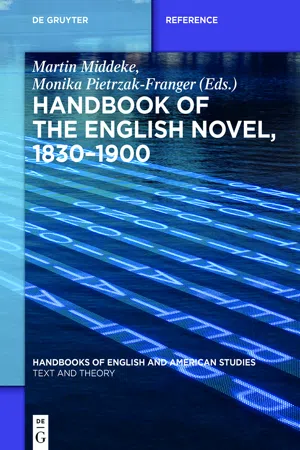
Handbook of the English Novel, 1830–1900
- 686 pages
- English
- PDF
- Available on iOS & Android
Handbook of the English Novel, 1830–1900
About this book
Part I of this authoritative handbook offers systematic essays, which deal with major historical, social, philosophical, political, cultural and aesthetic contexts of the English novel between 1830 and 1900. The essays offer a wide scope of aspects such as the Industrial Revolution, religion and secularisation, science, technology, medicine, evolution or the increasing mediatisation of the lifeworld. Part II, then, leads through the work of more than 25 eminent Victorian novelists. Each of these chapters provides both historical and biographical contextualisation, overview, close reading and analysis. They also encourage further research as they look upon the work of the respective authors at issue from the perspectives of cultural and literary theory.
Frequently asked questions
- Essential is ideal for learners and professionals who enjoy exploring a wide range of subjects. Access the Essential Library with 800,000+ trusted titles and best-sellers across business, personal growth, and the humanities. Includes unlimited reading time and Standard Read Aloud voice.
- Complete: Perfect for advanced learners and researchers needing full, unrestricted access. Unlock 1.4M+ books across hundreds of subjects, including academic and specialized titles. The Complete Plan also includes advanced features like Premium Read Aloud and Research Assistant.
Please note we cannot support devices running on iOS 13 and Android 7 or earlier. Learn more about using the app.
Information
Table of contents
- Editors’ Preface
- Contents
- 0. Metamorphoses in English Culture and the Novel, 1830–1900: An Introduction
- Part I: Systematic Questions
- 1. Science and the Victorian Novel
- 2. Remediating Nineteenth-Century Narrative
- 3. God on the Wane? The Victorian Novel and Religion
- 4. Genres and Poetology: The Novel and the Way towards Aesthetic Self-Consciousness
- 5. The Art of Novel Writing: Victorian Theories
- 6. Victorian Gender Relations and the Novel
- 7. Empire – Economy – Materiality
- Part II: Close Readings
- 8. Thomas Carlyle, Sartor Resartus (1833–1834)
- 9. Benjamin Disraeli, Sybil, or The Two Nations (1845)
- 10. Charlotte Brontë, Jane Eyre (1847)
- 11. Emily Brontë, Wuthering Heights (1847)
- 12. Anne Brontë, Agnes Grey (1847)
- 13. William Makepeace Thackeray, Vanity Fair (1847–1848)
- 14. Elizabeth Cleghorn Gaskell, Mary Barton (1848)
- 15. Charles Kingsley, Yeast: A Problem (1851)
- 16. Charles Dickens, Bleak House (1853)
- 17. Anthony Trollope, Doctor Thorne (1858)
- 18. Mary Elizabeth Braddon, Lady Audley’s Secret (1862)
- 19. Lewis Carroll, Alice’s Adventures in Wonderland (1865)
- 20. Wilkie Collins, The Moonstone (1868)
- 21. Edward Bulwer-Lytton, The Coming Race (1871)
- 22. George Eliot, Middlemarch (1871–1872; 1874)
- 23. George Meredith, The Egoist (1879)
- 24. Walter Pater, Marius the Epicurean (1885)
- 25. Robert Louis Stevenson, Strange Case of Dr. Jekyll and Mr. Hyde (1886)
- 26. Oscar Wilde, The Picture of Dorian Gray (1891)
- 27. Sarah Grand, The Heavenly Twins (1893)
- 28. George Moore, Esther Waters (1894)
- 29. Mona Caird, The Daughters of Danaus (1894)
- 30. Thomas Hardy, Jude the Obscure (1895)
- 31. H. G. Wells, The Time Machine (1895)
- 32. Bram Stoker, Dracula (1897)
- 33. Henry James, What Maisie Knew (1897)
- 34. Joseph Conrad, Lord Jim (1900)
- 35. Rudyard Kipling, Kim (1900–1901)
- 36. Samuel Butler, The Way of All Flesh (1903)
- Index of Subjects
- Index of Names
- List of Contributors